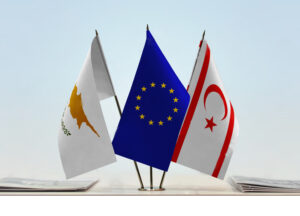EU and Northern Cyprus: Aid Programme for Turkish Cypriot Community and Green Line
In the context of the fifth enlargement of the EU of 1st May 2004 Cyprus joined the European Union (EU) as a de facto divided island. This created a unique geopolitical situation: while the entire country is considered to be EU territory, the northern part is beyond the control of the Greek Cypriot authority and therefore EU law do not apply there. However, the EU attempts to support the Turkish Cypriot community and makes efforts to support the negotiations between the two sides and reach a solution to the Cyprus problem.
 The policy of the EU with regard to the Turkish Cypriot community was set out by the General Affairs Council on 26 April 2004, just before Cyprus joined the EU:
The policy of the EU with regard to the Turkish Cypriot community was set out by the General Affairs Council on 26 April 2004, just before Cyprus joined the EU:
“The Turkish Cypriot community have expressed their clear desire for a future within the European Union. The Council is determined to put an end to the isolation of the Turkish Cypriot community and to facilitate the reunification of Cyprus by encouraging the economic development of the Turkish Cypriot community. The Council invited the Commission to bring forward comprehensive proposals to this end with particular emphasis on the economic integration of the island and on improving contact between the two communities and with the EU.”
 In this regard and in spite of some initial links with the Turkish Cypriots, the EU’s actual involvement in Northern Cyprus mostly started with the EU accession in 2004 and today continues with two main instruments: the Green Line Regulation and the Financial Aid Regulation.
In this regard and in spite of some initial links with the Turkish Cypriots, the EU’s actual involvement in Northern Cyprus mostly started with the EU accession in 2004 and today continues with two main instruments: the Green Line Regulation and the Financial Aid Regulation.
Since 1974 the “Green Line” separates the two parts of the island. The EU’s Green Line Regulation 866/2004, sets out the terms under which persons and goods can cross this line, which is not an external border of the EU.
As EU emphasized, the main practical effect is that the northern areas are outside the EU’s customs and fiscal territory – but this does not affect the personal rights of Turkish Cypriots as EU citizens.
Thus, EU adopted the Aid Programme for Turkish Cypriots Community to facilitate the reunification of Cyprus. The EU believes that establishing a functioning market surveillance system is of utmost importance for the functioning of the Turkish Cypriots as a democratic society, for undertaking effective reforms and for comprehensive settlement preparations.
Hence, the EU has allocated more than EUR 555 million to projects in support of the Turkish Cypriot community and development of northern part of Cyprus since 2006. You can read more about the EU aid programme for Turkish Cypriot community on our website.
Our law firm is based in Northern Cyprus (Kyrenia) and we have professional experience in the EU law and legal practice. Our lawyers have, on numerous occasions, assisted the Turkish Cypriot authorities in the legislative process and made a contribution to the legal system of Northern Cyprus.
At Erginel Law our lawyers and legal experts will be happy to guide you through the legal system in Northern Cyprus and will help you carry out your activities in accordance with the Green Line regulation. Furthermore, we can guide and assist you in the context of projects funded by the financial aid programs of the European Union.
Read also
Varosha was a bustling wealthy city and one of the most popular and attractive holiday…
UPDATED AS OF 23 MARCH, 2021 In accordance with the latest decision of the TRNC…
Since 2006, the European Union (EU) has allocated more than EUR 555 million to projects…
